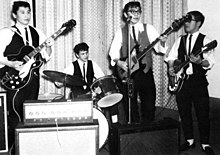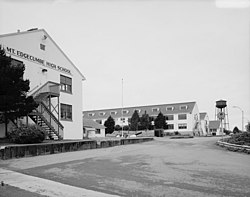|
Mt. Edgecumbe High School
Mt. Edgecumbe High School (abbreviated MEHS) is a public boarding high school in Sitka, Alaska in the United States. Located on Japonski Island, across Sitka Harbor from the northwestern corner of downtown Sitka, the school is situated on a portion of Sitka's former World War II-era military installations. Established in 1947 after the military abandoned the area, the school was originally operated by the federal Bureau of Indian Affairs (BIA) as part of a network of boarding high schools for Alaska Natives. These included schools in Eklutna and Wrangell. After several decades of operation by the BIA, the school was briefly closed in the 1980s. It was reopened by the Alaska Department of Education, which operates it today. For administrative and statistical purposes, MEHS is considered by the state to be a school district, albeit one consisting of only one school.[3] The enrollment was 421 students as of October 1, 2014. The student body, both in its former and current incarnations, is predominately from rural Alaska. For a time, until the resolution of the Tobeluk v. Lind lawsuit and the subsequent construction of K–12 schools in most rural communities, MEHS was one of the few viable options that many rural students had to obtain a high school education. The BIA schools in rural villages provided schooling only until the eighth grade. Today, the school still attracts rural residents, primarily students from communities too small to qualify for state school funding. It also attracts exceptional athletes who seek to develop their skills beyond the competition within their local school districts. The school is named for Mount Edgecumbe, which is located on Kruzof Island. It is a 3,077 feet (938 m) high, historically active volcano[4] that is visible from the campus. The mountain was named by British Captain James Cook in 1778 for George, Earl of Edgecumbe. Outside of the school year, the campus has hosted summer camps such as the Sitka Fine Arts Camp. This has relocated to the campus of the former Sheldon Jackson College, which has closed. In 2018 it hosted a portion of the inaugural Outer Coast College Summer Seminar. History In 1947, the federal government established Mt. Edgecumbe High School to provide higher education to rural Alaska Native students and to use the World War II installation on Japonski Island in Sitka. This was no longer needed by the military. The school was originally administered by the Bureau of Indian Affairs. Together with the Native Alaskan boarding schools in other parts of the state, it helped educate today's leaders from rural areas. By 2015, several MEHS graduates had been elected to the Alaska Legislature.[needs update] In the 1980s, the school was closed for a year. The facility was transferred to the State of Alaska, which has administered the institution since. GovernanceThe Alaska State Board of Education serves as the school board for Mt. Edgecumbe High School.[5] Educational modelMt. Edgecumbe is known for developing educationally disadvantaged students from rural Alaska. Ninety percent of its students attend universities and college after graduation. All students are required to learn a non-indigenous second language; most choose Chinese or Japanese. Students are also required to familiarize themselves with an array of technologies, and to participate in the academic environment; for example, classes are held on Saturdays once a month. Each member of the MEHS faculty is in charge of a kind of "extended family" scheme, in which teachers develop closer connections with small groups of students. The faculty members eat dinner with their students at the school cafeteria every Thursday to help build personal connections with students and strengthen the community at the school. MEHS is known for its unique science program. It includes a high-level SeaTech program that partners with the Whale Acoustics Lab at Scripps Institution of Oceanography and NOAA to research marine mammal acoustics. Extracurriculars Mt. Edgecumbe's sports teams are known as the Braves, for male athletes, and the Lady Braves for female athletes. The school is especially recognized for both its boys' and girls' basketball teams. MEHS, classified as a 3A school by the Alaska School Activities Association, has made repeated runs to state championships with its basketball teams. The Lady Braves program has done exceptionally well in regional play; since 1993-1994 the Lady Braves have made fourteen appearances at the state tournament. In the 2008–2009 season, the Lady Braves made the school's first appearance at a state basketball championship game, playing Anchorage Christian Schools (ACS), eventually losing 32–28. In 2010, the Lady Braves captured the school's first state basketball championship after defeating ACS 32–26. In 2014, the Lady Braves made a repeat appearance at the state championship, eventually losing to ACS. Besides basketball, its competitive drama, debate and forensic team has been successful at the state level, winning a state championship in drama in 2004. The school has produced many quality wrestling and volleyball teams as well. In recent years, the Lady Braves volleyball team has been successful. Since 2005 they have finished as the Class 3A State runner-up three times, and won state championships in 2011, 2012, 2014, and 2016. Historically, Edgecumbe was known for its running teams. In the 1960s and early 1970s MEHS won 11 consecutive regional championships in cross-country. They last made it to a regional championship n 2008. In 2011 and 2014, the Lady Braves volleyball team advanced to state and took first place. All wrestling matches, volleyball and basketball games are played at the B.J. McGillis Field House, a former World War II-era aircraft hangar. Since this is one of the larger sports venues in Southeast Alaska, rivalry games and regional championships often attract crowds exceeding 1,500 spectators. The facility has standard bleachers, reserved seating, a press box, a climbing wall, wrestling mats, and a weight training center. It is the only school in the region with a gymnasium large enough to hold two basketball courts. MEHS's traditional rivals include its cross-town 3A rival Sitka High School (their matchups are known as the "Battle of the Bridge", alluding to the respective schools' locations on different sides of the John O'Connell Bridge). In the school's earliest years, they also had a cross-town rivalry with Sheldon Jackson High School, a sectarian boarding school that developed as Sheldon Jackson College. (It has since closed.) Enrollment and demographicsMt. Edgecumbe expanded from 370 to 400 students in 2004.[6] The Alaska Department of Education & Early Development reported that the school had an enrollment of 421 students on October 1, 2014: 109 freshmen, 110 sophomores, 106 juniors and 96 seniors.[7] The school normally has 140 openings, while 300 students usually apply every year. In 2005, more than 100 communities throughout Alaska were represented among MEHS's student body. Ninety percent of MEHS's student body is Alaska Native,[8] with the majority hailing from rural Alaska.[9] The school makes some efforts to promote the cultural identity of Alaska Natives; there are several student-led Alaska Native dance groups. Sister schoolMt. Edgecumbe High School has a sister school relationship with Muroran Shimizugaoka High School (北海道室蘭清水丘高等学校) on the Japanese island of Hokkaido. See alsoReferences
External links
|
||||||||||||||||||||||||||||||||||||||||


